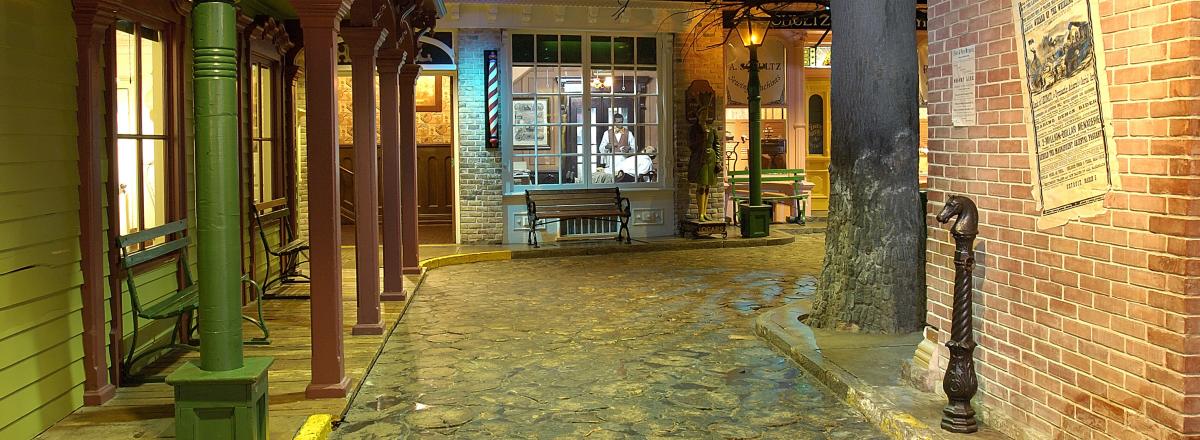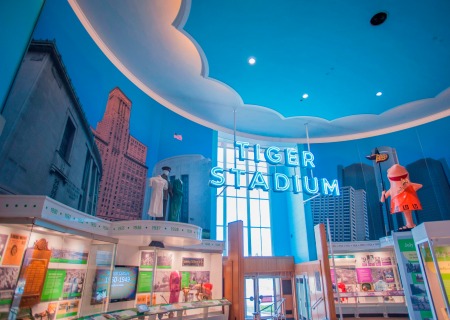Detroit Historical Museum

Cobblestone streets, 19th century stores, an auto assembly line, toy trains and a fur trading post from the 1700s are only a few of the wonders visitors see at the Detroit Historical Museum. For over 90 years, the Museum has chronicled the life and times of the region, safeguarding its rich history. Here is “the history of its history.”
The Founding of the Museum
When attorney and historian Clarence M. Burton donated his collection of historical papers to the Detroit Public Library in 1914, he triggered a chain of events that led to the creation of the Detroit Historical Museum. In December 1921, Burton brought together 19 prominent local historians to found the Detroit Historical Society, an organization dedicated to the preservation of the city’s history. In 1927, membership offices were leased and our treasurer J. Bell Moran was appointed to set up a museum. A curator was hired and on November 19, 1928, the “highest museum in the world” opened in a one-room suite on the 23rd floor of the Barlum Tower, now the Cadillac Tower downtown.
The Museum’s History
Although the Great Depression in the 1930s hit the region hard, the 1940s brought success to our efforts to build a permanent museum. In 1942, popular Detroit News columnist George W. Stark became president of the Society. Stark commanded the respect and influence necessary to raise the considerable funds needed to construct a new museum. By 1945, we had raised more than $250,000 and decided to offer both the money raised and our 15,000 item collection to the City of Detroit, in exchange for the city’s agreement to create a historical commission to build and operate the planned museum.
On July 24, 1951, the 250th anniversary of Detroit’s founding, a ceremony took place to dedicate the new museum. In attendance were dignitaries including Governor G. Mennen Williams, Mayor Albert E. Cobo, U.S. Senator Homer Ferguson, the French and British ambassadors and Detroiter Ralph Bunche of the United Nations.
Through the 1950s and 1960s, the Museum became one of the leading cultural institutions in the Midwest through its changing exhibits, tours, special events and educational programs.
Recent History
 By the 1990s, the Museum rode a wave of success. In 1993, we raised nearly $4 million for exhibits, educational programs and an endowment fund for the Museum. A new permanent exhibit, made possible by the success of the campaign, opened in 1995 -- The Motor City. This exhibit traces Detroit’s development into the Automobile Capital of the World and includes an operating assembly line with a two-story body drop from the General Motors Cadillac Division Clark Street Plant. In 1998, the Museum opened another permanent exhibition, Frontiers to Factories: Detroiters at Work 1701-1901. This exhibit depicts the city’s first 200 years, as it grew from a French fur trading post to a major industrial center.
By the 1990s, the Museum rode a wave of success. In 1993, we raised nearly $4 million for exhibits, educational programs and an endowment fund for the Museum. A new permanent exhibit, made possible by the success of the campaign, opened in 1995 -- The Motor City. This exhibit traces Detroit’s development into the Automobile Capital of the World and includes an operating assembly line with a two-story body drop from the General Motors Cadillac Division Clark Street Plant. In 1998, the Museum opened another permanent exhibition, Frontiers to Factories: Detroiters at Work 1701-1901. This exhibit depicts the city’s first 200 years, as it grew from a French fur trading post to a major industrial center.
In March 2006, we once again assumed operational responsibility for the Museum, after signing a formal agreement with the City of Detroit. Four months later, the Museum closed for an extensive “Museum Makeover,” reopening on September 29, 2006 with new exhibits and a new customer-focused orientation.
Today, as we continue the Past>Forward Campaign, major upgrades and improvements have been made, the first renovations of this scale since the Museum was expanded to its current size in the 1960s. The Grand Re-Opening weekend was celebrated November 23 - 25, 2012.
The improvements include:
• Three new permanent exhibits: The Gallery of Innovation, The Allesee Gallery of Culture and Detroit: The Arsenal of Democracy
• An expanded Doorway to Freedom: Detroit and the Underground Railroad exhibit
• Updated Streets of Old Detroit and America’s Motor City exhibits.
In addition, the plaza outside the building has been transformed into Detroit Legends Plaza, an outdoor destination meant to honor Detroit’s stars of sports, entertainment and media. Detroit legends from Gordie Howe to Martha Reeves to Lily Tomlin have already cast their handprints and signatures in cement. The project, an ongoing endeavor that will take several years to complete, prominently displays the handprints and signatures for all to see.
In 2015, the Detroit Historical Society launched its transformational Detroit 67: Looking Back to Move Forward project as a long-term effort to engage the Detroit community in its efforts to plan a meaningful commemoration of the tumultuous summer of 1967. This first-of-its-kind effort enabled the museum to base development of programs and an exhibition on public input, ensuring that a broad spectrum of perspectives is represented. The project continues through 2020, with:
• The Detroit 67: Perspectives exhibition on display through May 2020. Group tours (for 10-30 participants) are available by appointment, or the exhibition is free with general admission.
• Detroit 67 public programming, including the popular Third Thursday Speaker Series, held monthly, and an immersive Spring Break experience, Detroit Design 2067, returning in Spring 2020 for 11th and 12th graders.
• The Neighborhoods Oral History Project, a new effort to collect and preserve Detroit’s neighborhood history from the perspective of current and former residents, which is underway now.
The Detroit 67 project has received numerous awards, including the 2018 National Medal from the Institute of Museum and Library Services and 2018 History in Progress (HIP) Award from the American Association for State and Local History.

